
endangered
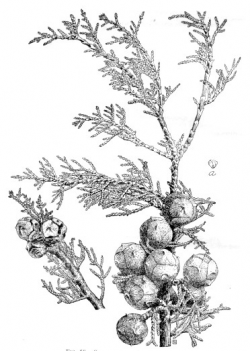
Illustration from Sudworth (1908).
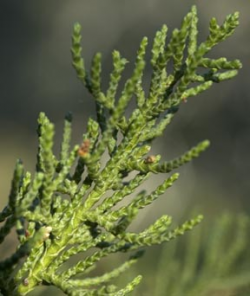
Photo taken at the Bonny Doon Ecological Reserve © 2007 Dylan Neubauer.
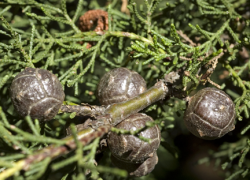
Photo © 2007 Dylan Neubauer.
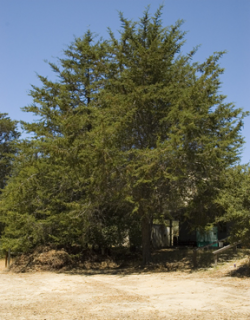
Photo © 2007 Dylan Neubauer.
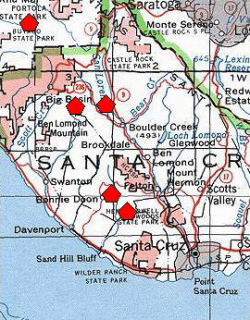
A red polygon indicates an extant occurrence.



This fact sheet was prepared by Dylan M. Neubauer under award NA04N0S4200074 from the National Oceanic and Atmospheric Administration (NOAA), U.S. Department of Commerce (DOC). The statements, findings, conclusions, and recommendations are those of the authors and do not necessarily reflect the views of the NOAA or the DOC.
© Copyright 2006, Elkhorn Slough Coastal Training Program
Last updated: Jun 19, 2007 13:16
Common Names - Santa Cruz cypress
Family - Cupressaceae (Cypress Family)
State Status - state endangered
(November 1979)
Federal Status - federal endangered
(January 1987)
Habitat
Sandy or gravelly, low-nutrient soils generally derived from sandstone or granite in chaparral or knobcone pine (Pinus attenuata) forest surrounded by coast redwood (Sequoia sempervirens) forest or stands of Pacific ponderosa pine (Pinus ponderosa var. pacifica); 370-760 m.
Key Characteristics
Small trees to 15 m tall, sparingly branched when young; bark fibrous, thin, broken in thick vertical strips or plates, gray-brown; needles scale-like, bright to deep green; male cones 3–4 mm long by 2 mm wide, ± quadrangular, pollen sacs 4–6 per scale; mature seed cones 16–25 mm long, 14-22 mm wide, spheric to generally widely elliptic, brown, scales 8–10, each bearing a small umbo ca. 2 mm long (this often weathers away); seed 3–5 mm (Bartel 2013).
Flowering Period
Male cones—February to March; female cones—March to May; cones ripen August (can be identified year-round).
Reference Population
Bonny Doon Ecological Reserve (Santa Cruz County).
Global Distribution
Endemic to the Santa Cruz Mountains of central coastal California in Santa Cruz County (Bartel 2013).
Conservation
The taxonomy of the western hemisphere (New World) cypresses has been unstable, especially during the last decade (Terry et al. 2011). Based on molecular phylogenetic studies, Adams et al. (2009) erected a new genus (Hesperocyparis) for western hemisphere cypresses that had been traditionally placed in Cupressus, and this is the treatment used by Bartel (2013) in the Jepson eFlora. Other treatments have considered H. abramsiana (and H. pygmaea) as indistinct from H. goveniana (Eckenwalder 1993) or as a variety of H. g. (along with H. p.) (Silba 1981, Little 1970). A 2009 study examining DNA in volatile leaf oils (Adams and Bartel) differentiated between the four Santa Cruz County populations (Bonny Doon, Bracken Brae, Eagle Rock, and Majors Creek) and the single San Mateo County population (Butano Ridge) and described two varieties: H. a. var. abramsiana and H. a. var. butanoensis. H. a. var. a. differs from H. a. var. b. by its longer seed cones (Bartel 2013).
Demographic studies (McGraw 2007, Taylor in litt. 2005, cited in USFWS 2013a) have resulted in much-improved information regarding abundance and areal extent of this taxon. It appears that there are far greater numbers than previously estimated, though the aereal extent is lower (USFWS 2013a). Since the time of listing, three of the four populations are predominantly on public lands (USFWS 2013a). The fourth and possibly largest population (with approximately 10,000 to 20,000 individuals) is at Bracken Brae on private property, though development there is restricted by county ordinance and state regulations (USFWS 2013a).
The Bonny Doon population (the majority of which occurs on the Bonny Doon Ecological Reserve) (USFWS 2013a) was significantly affected by the 2008 Martin Road fire, with all of the mature trees killed within the 156 acres that burned severely--approximately half of the population (USFWS 2013a). A 2011 regeneration study (McGraw, cited in USFWS 2013a) indicated that post-fire recruitment was vigorous, with germination occurring up to two years following the fire. Over time, self-thinning is expected to occur as plants compete for available space, light, and nutrients (USFWS 2013a). Long-term monitoring is required to determine if these new recruits will replace pre-fire stand numbers (USFWS 2013a).
In 2015, a single tree was located in the Scott Creek watershed near Scott Creek.
Santa Cruz cypress requires a large-scale disturbance such as fire to regenerate successfully (USFWS 2013a). Seeds require sunlight and bare mineral soil to germinate in large stand-replacing numbers (USFWS 2013a). Lacking fire, trees senesce and seed viability and potential habitat area both decrease, resulting in the eventual death of the stand (USFWS 2013a). Further research is needed to study the potential of mechanical disturbance or controlled burns to stimulate recruitment (USFWS 2013a).
The USFWS (2013b) has proposed downlisting Santa Cruz cypress from endangered to threatened status as it considers the primary threats present at the time of listing have been mostly addressed. However, it asserts that a continuing high-level threat is the low level of regeneration due to the alteration of fire regimes combined with lack of management that encourages recruitment (USFWS 2013a). Other threats to this species include reproductive isolation, climate change and invasive species (USFWS 2013a).
References
Adams, R. P. and J. A. Bartel. 2009. Infraspecific variation in Hesperocyparis abramsiana: issrs and terpenoid data. Phytologia 91(2):287–299.
Adams, R. P., J. A. Bartel, and R. A. Price. 2009. A new genus, Hesperocyparis, for the cypresses of the western hemisphere. Phytologia 91(1):160–165.
Bartel, J. A. 2013. Hesperocyparis abramsiana var. abramsiana, in Jepson Flora Project (eds.). Jepson eFlora, http://ucjeps.berkeley.edu/cgi-bin/get_IJM.pl?tid=89293 [accessed 15 February 2015].
CNPS, Rare Plant Program. 2010. Hesperocyparis abramsiana var. abramsiana, in Inventory of Rare and Endangered Plants (online edition, v8-02). California Native Plant Society, Sacramento, CA. http://www.rareplants.cnps.org/detail/532.html [accessed 15 February 2015].
Eckenwalder, J. E. 1993. Cupressus. In: Flora of North America Editorial Committee, eds. 1993+. Flora of North America North of Mexico, Vol. 2. Oxford University Press, New York and Oxford, NY.
Little, E. L. 1970. Names of the New World cypresses (Cupressus). Phytologia 20:429–445.
McGraw, J. M. 2007. Distribution, abundance, size structure, and conservation status of three populations of the endangered Santa Cruz cypress (Callitropsis abramsiana). Prepared for the U.S. Fish and Wildlife Service, Ventura Fish and Wildlife Office, Ventura, CA.
McGraw, J. M. 2011. Effects of fire and manual vegetation removal on recruitment of the endangered Santa Cruz cypress (Hesperocyparis abramsiana var. abramsiana) within the Bonny Doon Ecological Reserve. Santa Cruz County, California. Report prepared for the U.S. Fish and Wildlife Service, Ventura Fish and Wildlife Office, Ventura, CA.
Silba, J. 1981. Revised generic concepts of Cupressus L. (Cupressaceae). Phytologia 49:390–399.
Sudworth, G. B. 1908. Forest Trees of the Pacific Slope. United States Government Printing Office, Washington, D.C.
Taylor, D. W. 2005. Comments on preliminary surveys of Santa Cruz cypress at Bracken Brae. Email to Connie Rutherford, U.S. Fish and Wildlife Service, Ventura, CA [18 March 2005].
Terry, R. G., J. A. Bartel, and R. P. Adams. 2012. Phylogenetic relationships among the New World cypresses (Hesperocyparis; Cupressaceae): evidence from noncoding chloroplast DNA sequences. Plant Systematics and Evolution 298:1987–2000.
U.S. Fish and Wildlife. 2013a. Santa Cruz cypress (Hesperocyparis [Cupressus] abramsiana) species report. Ventura Fish and Wildlife Office, Ventura, CA.
U.S. Fish and Wildlife. 2013b. 12-month Finding on a Petition to Downlist Hesperocyparis abramsiana (=Cupressus abramsiana), and Proposed Rule to Reclassify H. abramsiana as Threatened. Federal Register 78(170):54221-54231. http://www.gpo.gov/fdsys/pkg/FR-2013-09-03/pdf/2013-21313.pdf [accessed 15 February 2015].
